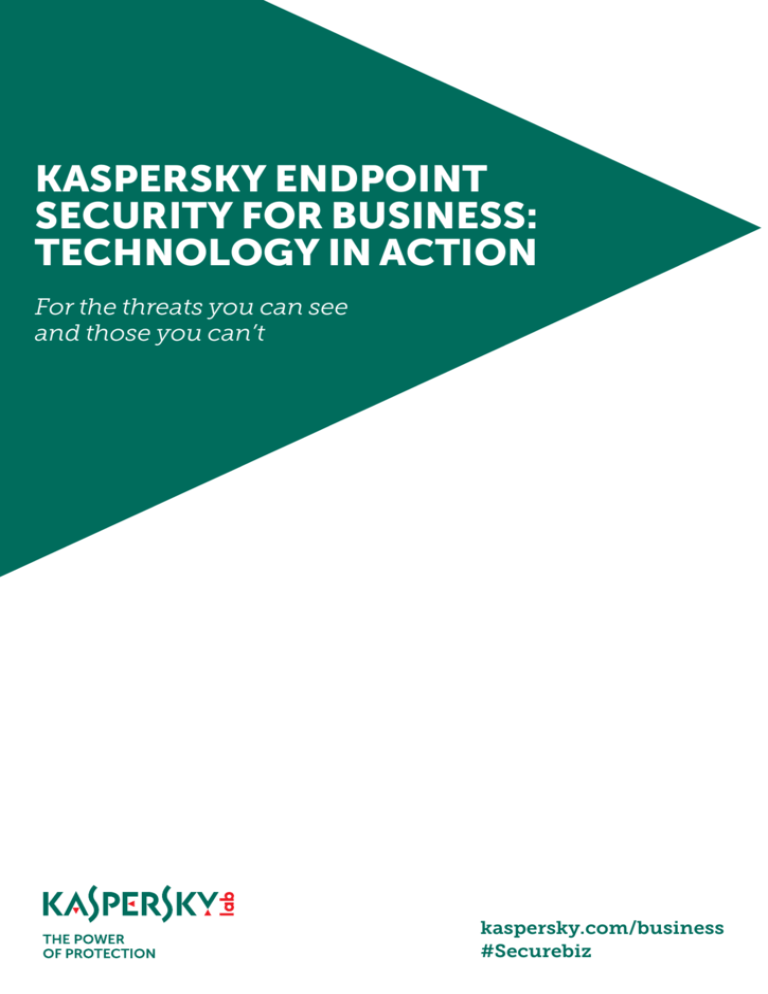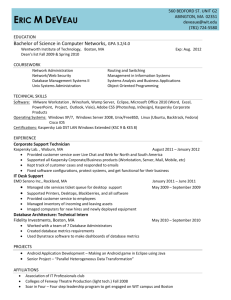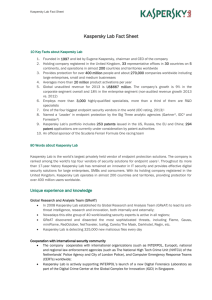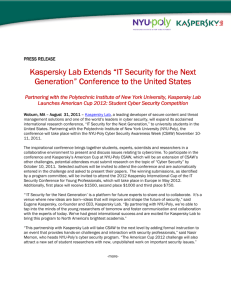
KASPERSKY ENDPOINT
SECURITY FOR BUSINESS:
TECHNOLOGY IN ACTION
For the threats you can see
and those you can’t
kaspersky.com/business
#Securebiz
CONTENTS
Protect your business from the threats you can see
and those you can’t
3
What you can’t see
Proactive, reactive, intelligent
4
Detecting known threats
6
Detecting unknown threats
7
Detecting advanced threats
8
Kaspersky Lab: best protection in the industry
9
2
5
94% of companies have
experienced some form
of external security threat
Source: Kaspersky Lab Global IT Risks Report 2014
PROTECT YOUR BUSINESS FROM
THE THREATS YOU CAN SEE…
AND THOSE YOU CAN’T
Having the right IT security in place has never
been more important.
WHAT YOU DON’T KNOW CAN HURT YOU
More than 30 per cent of security breaches occur at companies with 100 or fewer
employees.1 44 per cent of small-and-medium-sized businesses (SMBs) have been
attacked by cybercriminals.2
Yet many are unaware of the very real threats that cybercrime and advanced
malware pose to their business. While just under a fifth of smaller businesses admit
they’ve taken no steps to guard against cybercrime, only 60 per cent actively keep
their anti-malware software up-to-date.3
Thinking you’re too small to be of interest is exactly the mindset that cybercriminals
are exploiting to launch increasingly sophisticated malware against your business.
They know what many SMBs don’t: You are a target.
Verizon’s 2013 Data Breach Investigations Report
2013 survey by the National Small Business Association
3
Kaspersky Lab, Threatpost, May 24, 2013
1
2
3
WHAT YOU CAN’T SEE
Let’s assume you’re one of the 80 per cent of SMBs with some kind of IT security
solution in place. Don’t get too complacent: most business users grossly
underestimate threat volumes.4 Only four per cent of those surveyed came
anywhere close to guessing how many threats are detected each day.4
PERCEIVED NUMBER OF NEW MALWARE SAMPLES DISCOVERED DAILY (%)
1–100
23
100–1,000
25
22
1,000–10,000
10,000–100,000
14
7
100,000–250,000
4
250,000–350,000
350,000–500,000
More than 500,000
2
3
Source: Kaspersky Lab Global IT Risks Report 2014
In this context, it’s hardly surprising that some users view IT security as a
‘commodity’, seeing little difference between the various options available to them.
That’s a dangerous myth; even a one per cent difference in detection rates can
result in hundreds of thousands of pieces of malware slipping through the nets
over the course of a year. How do we know that?
•Kaspersky Lab detects 325 000 new pieces of malware every single day.
•In the second quarter of 2014, our anti-malware solutions detected 528 799 591
virus attacks on end user systems, identifying a total of 114 984 065 unique
malicious objects in the process.5
The most dangerous threats are the ones you don’t know about – the threats
Kaspersky Lab experts monitor, analyse and mitigate every day. We look for trouble.
And when we find it, we use more than a decade’s worth of threat intelligence and
expertise to provide the additional protection against the threats your organisation
most needs to avoid – especially when it comes to advanced malware and
Advanced Persistent Threats (APTs).
There’s an increasing gulf between what businesses
believe the threat landscape to be and what it
actually is. We’ve called this the ‘perception gap’.
It shows that organisations, no matter what their
size, wildly underestimate both the amount and
severity of the threats they face.
Costin Raiu, Global Research & Analysis Team, Kaspersky Lab
Kaspersky Lab Global IT Risks Report 2014
5
Kaspersky Lab Q2 Threat Evolution Report 2014
4
4
PROACTIVE, REACTIVE,
INTELLIGENT
Kaspersky Lab has a long track record in making some of the highest profile, most
relevant threat discoveries, including Carbanak (the world’s biggest cyber bank
heist), Dark Hotel, The Mask, Icefog and Red October. More than a third of our
employees work in Research and Development. They focus solely on developing
technologies to counteract and anticipate the constantly evolving threats our
dedicated teams of Intelligence and Analysis Researchers investigate every day.
Kaspersky Lab’s understanding of the inner workings of some of the world’s
most sophisticated threats has enabled us to develop a multi-layered platform
of security technologies to fight against known, unknown and advanced threats.
Our technologies detect and mitigate the threats you can see – as well as those
you can’t.
How do we do it? Here’s a walk through how Kaspersky Lab’s multiple anti-malware
and threat detection technologies work together simultaneously, from the moment
a file is loaded. It’s a unique combination of intelligence-led technologies that
deliver multi-layered, comprehensive threat detection and prevention across
endpoints and other IT infrastructure elements.
5
DETECTING
KNOWN THREATS
From the moment a file is about to be downloaded, web page opened or application
launched, Kaspersky Lab’s advanced anti-malware engines simultaneously check,
detect and protect against known, unknown and advanced web and mail-based
viruses, Trojans, rootkits, worms, spyware, scripts, adware and other known
malicious objects and threats. Beginning with known threats, at its core, these
engines comprise:
NETWORK ATTACK BLOCKER
URL FILTERING
Scans all network traffic, using known
signatures to detect and block network-based
attacks, including port scanning, denial-ofservice (DoS) attacks, buffer overruns and
other remote malicious activity.
Scans and checks URLs in inbound/outbound
traffic against Kaspersky Lab’s database
of known malicious and phishing sites,
blocking web-based attacks, server-side
polymorphic malware and ‘command and
control’ (C&C) servers.
BLACKLISTING
FIREWALL
Dedicated teams of malware analysts keep
Kaspersky Lab’s databases up to date with
the latest malware signatures and data.
These are used to automatically block all
known malware.
Analyses every packet entering and leaving
the network, blocking or allowing them,
depending on the security risk. Unauthorised
connections are blocked, decreasing the
attack surface and possibility of infection.
Infected or otherwise compromised
machines have their network activity
limited, reducing their ability to spread
malware and limiting damage caused by
security policy violations.
Kaspersky Lab’s signature-based technologies
are built on years of accumulated knowledge and
experience. All of the above technologies excel at
blocking known malware (and thanks to Kaspersky
Security Network, as described later, many threats
stay unknown for only a short period of time).
But what about the elusive unknown or advanced
threats we mentioned earlier? We’ve got that
covered too…
6
aspersky Lab’s Anti-Spam technology scored first place in VB Spam Test
K
November 2014, with a detection rate of 99.75% and zero false positives.
6
DETECTING
UNKNOWN THREATS
Once any file has passed through the signature-based checks for known threats,
it’s time to take a look at what happens at the moment of the launch attempt.
Kaspersky Lab’s multi-layered, proactive technologies analyse and check files
as they execute, searching for suspicious or malicious activity that suggests an
unknown threat is at play.
HEURISTICS
APPLICATION CONTROL AND WHITELISTING
Heuristic analysis provides proactive
protection from threats that can’t be detected
using conventional anti-virus databases.
Kaspersky Lab’s heuristics enable the
detection of new malware or unknown
modifications to known malware. Static
analysis scans code for signs of suspicious
commands associated with malware, while
dynamic analysis examines the machine code
the file might try to execute, responding to
emulated ‘calls’ with likely ‘answers’ to
establish whether the code is safe or not.
Application control blocks or allows
administrator-specified applications.
Kaspersky Lab’s approach is built on Dynamic
Whitelisting – continuously updated lists of
trusted applications and software categories
that are only allowed to run according to
specified rules and policies. Kaspersky Lab
has a dedicated whitelisting lab and database
of more than one billion files, growing at a
rate of one million per day.
Application Controls and Whitelisting reduce
the risks posed by threats we don’t yet know
about; most malware is delivered as an
executable file that will not be found on
any whitelist. Organisations that adopt this
approach (and the supporting technologies)
can thus prevent any malicious file from
executing, without needing to identify or
know what those files actually are.
HEURISTIC ANTI-PHISHING
In extremely new phishing attacks where
only a small number of users have been
affected, Kaspersky Lab’s technology can
look for additional evidence of suspicious
activity, such as vocabulary, input forms or
unreadable sequences of symbols. This is in
addition to the more traditional, database-led
approach described earlier.
KASPERSKY SECURITY NETWORK
Effectively a global, cloud-based threat
laboratory, Kaspersky Security Network
detects, analyses and manages known,
unknown and new threats and online attack
sources in seconds – and delivers that
intelligence straight to customer systems.
Phishing-based threats have been the starting
point for many recent, highly dangerous
advanced threats.
HOST INTRUSION PREVENTION SYSTEM (HIPS)
Kaspersky Lab’s HIPS adds an additional
layer of protection, detecting and managing
suspicious applications and activity,
preventing threats from launching. HIPS
helps control how applications behave,
setting trust levels after the initial analysis.
These levels define what resources they
can use, what kind of data they can access
or modify, etc. It restricts execution of
potentially dangerous programs without
affecting the performance of authorised,
safe applications. An untrusted application
will not be allowed to do anything – including
launch.
Using real-time, anonymised data from 60
million endpoint sensors globally, every file
that passes through Kaspersky Lab protected
systems is subject to analysis based on
relevant threat intelligence. The same data
ensures the most appropriate action is
taken; working together with all the other
components of Kaspersky Lab’s engine,
Kaspersky Security Network enables
protection from unknown threats before
signatures are available – traditional
signature-based responses can take several
hours, Kaspersky Security Network takes
about 40 seconds.
7
DETECTING
ADVANCED THREATS
Your file has been downloaded and started; Kaspersky Lab technologies have
scanned, analysed, applied intelligence and either blocked or allowed based on
known as well as unknown threats.
But what about Advanced Threats?
Kaspersky Lab’s advanced threat detection technologies are designed to detect
and block advanced threats, using a range of proactive, sophisticated behavioural
mechanisms that monitor process behaviours, discern suspicious patterns, block
malicious activities and roll back harmful changes, including Cryptors.
Let’s take a look…
SYSTEM WATCHER
ROLLBACK
This monitors and collects data on application
and other important system activities using
tracking activities and discerning
behavioural patterns. This information
is provided to the other Kaspersky Lab
protection components we’ve described. Any
activity that corresponds to threat patterns is
dealt with according to administrator-set
policies – or use the default setting, which
is to terminate the malicious process and
quarantine for later analysis.
This continuous, detailed monitoring
of systems enables exceptionally accurate
system Rollback functionality, limiting
the impact of any infection and returning
systems to previous, secure parameters.
Rollback mechanisms are updateable and
work with created and modified executable
files, MBR modifications, important Windows
files and registry keys.
DEFAULT DENY
The driver that intercepts file operations
for Kaspersky’s anti-malware component also
gathers information on changes made to the
registry, while the firewall gathers data on
the network activity of applications. All of
this information is fed into System Watcher
which, in turn, has its own module capable
of reacting to complex system events, such
as installation of drivers.
Increasingly viewed as the most effective
security posture to adopt in the face of
ever-evolving, advanced threats. It simply
blocks all applications from running on any
workstation – unless they’ve been explicitly
allowed by the administrator.
Default Deny means all new, file-based
malware varieties are automatically blocked,
even for targeted attacks.
Malicious actions and destructive behaviour
patterns suggestive of malware are blocked.
AUTOMATIC EXPLOIT PREVENTION (AEP)
This technology specifically targets malware
that exploits software vulnerabilities.
Developed through in-depth analysis
of the features and behaviours of the
most widespread exploits, the resulting
technology is capable of identifying
exploit-characteristic behaviour patterns –
and blocking them from completion.
A SMALL CHANGE CAN MAKE
A BIG DIFFERENCE
As we’ve seen, even a single additional
percentage point in detection rate can translate
into hundreds of thousands of pieces of
malware slipping through the nets. We’ve also
seen how Kaspersky Lab’s additional ‘nets’ of
mitigation, detection, and analysis can catch
unknown and even advanced threats before
they can do their work.
AEP acts like a safety net, an extra layer of
security that complements Kaspersky Lab’s
other technologies. It works in conjunction
with Kaspersky Lab’s System Watcher.
8
Score of TOP3 places
KASPERSKY LAB: BEST IN
THE INDUSTRY PROTECTION*
100%
80%
Kaspersky Lab
1st places – 51
Participation in 93
tests/reviews
TOP 3 = 71%
Bitdefender
60%
Avira
ESET
Qihoo 360
40%
Kingsoft
Trend Micro
G DATA
Symantec
Bullguard
20%
Sophos
AhnLab
Panda Security
Tencent
Threat Track (VIPRE)
0%
20
40
Microsoft
Intel Security (McAfee)
F-Secure
AVG
Avast
No. of independent tests/reviews
60
80
© 2015 Kaspersky Lab. All rights reserved. Registered trademarks and service marks are the property of their respective owners.
Independent test results consistently demonstrate that Kaspersky Lab provides the
best protection in the industry. In 2014 alone, we participated in 93 independent
tests and reviews, ranking first 51 times and finishing in the top three a record 71 per
cent of the time. That’s just one of the reasons why OEMs – including Microsoft,
Cisco Meraki, Juniper Networks and Alcatel Lucent – trust Kaspersky Lab to provide
the security they ship within their own products.
All of Kaspersky Lab’s security technologies are developed and maintained inhouse, from the same code base, meaning they all integrate seamlessly with each
other, building a multi-layered platform that’s greater than the sum of its parts.
This level of integration also translates into enhanced performance, faster updates
and a unified look and feel across all solutions – giving you time to focus on what
you do best, while Kaspersky Lab takes care of security.
* Notes:
According to summary results of independent tests in 2014 for corporate, consumer and mobile products.
Summary includes tests conducted by the following independent test labs and magazines:
AV-Comparatives, AV-Test, Dennis Technology Labs, MRG Effitas, NSS Labs, PC Security Labs, VirusBulletin.
The size of the bubble reflects the number of 1st places achieved.
9
100
GET STARTED NOW:
FREE 30 DAY TRIAL
Discover how our premium
security can protect your
business from malware
and cybercrime with a
no-obligation trial.
Visit kaspersky.com/trials
today to download full product
versions and evaluate how
successfully they protect your
IT infrastructure, endpoints and
confidential business data.
GET YOUR FREE TRIAL NOW
JOIN THE CONVERSATION
#Securebiz
Watch us on
YouTube
Like us on
Facebook
Follow us on
Twitter
Join us on
LinkedIn
Review
our blog
Join us on
Threatpost
View us on
Securelist
View us on
SlideShare
ABOUT KASPERSKY LAB
Kaspersky Lab is the world’s largest privately held vendor of endpoint protection
solutions. The company is ranked among the world’s top four vendors of security
solutions for endpoint users*. Throughout its more than 17-year history Kaspersky
Lab has remained an innovator in IT security and provides effective digital security
solutions for large enterprises, SMBs and consumers. Kaspersky Lab, with its
holding company registered in the United Kingdom, currently operates in almost
200 countries and territories across the globe, providing protection for over 400
million users worldwide. Learn more at www.kaspersky.com.
* The company was rated fourth in the IDC rating Worldwide Endpoint Security Revenue by Vendor, 2013.
The rating was published in the IDC report “Worldwide Endpoint Security 2014–2018 Forecast and 2013
Vendor Shares (IDC #250210, August 2014). The report ranked software vendors according to earnings
from sales of endpoint security solutions in 2013.
kaspersky.com/business
#Securebiz







